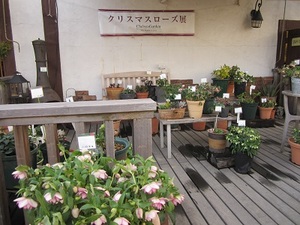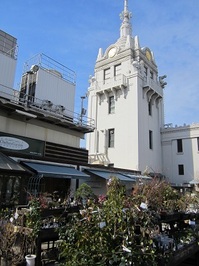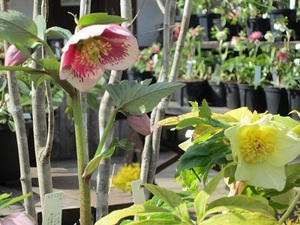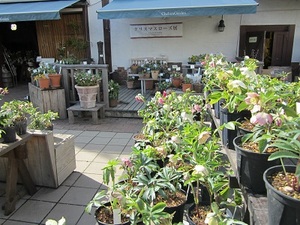Colored by numerous history, Chuo-ku encounters interesting historical sites and places related to wherever you walk. On this day, I walked around the Kyobashi area.
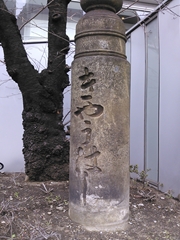
In recent years, redevelopment has progressed around here, and [Kyobashi Square Garden], which has a studio with [FM Chuo] closely related to sightseeing correspondents, has become a new landscape.
Near the building, the familiar "Kyobashi main pillar" is left. "Kyobashi" was built over the Kyobashi River, which was reclaimed for the construction of the Metropolitan Expressway during the previous Olympics. It has been more than half a century since the river disappeared in 1959 (Showa 34). However, if you look at this main pillar, you can remember the past.
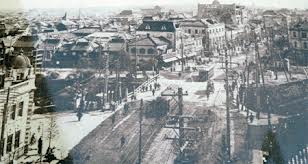 In the past, there was a vegetable unloading area on the northwest side of the Kyobashi River, and it was very busy called [daikon riverbank]. They traded vegetables brought from rural areas near Tokyo here, and it is the prototype of the fruit and vegetable market today. In the past, a lot of suburban vegetables such as Kameido Daikon and Nerima Daikon were transported using water transportation, and it seems that they were called "daikon riverbank" from that impression.
In the past, there was a vegetable unloading area on the northwest side of the Kyobashi River, and it was very busy called [daikon riverbank]. They traded vegetables brought from rural areas near Tokyo here, and it is the prototype of the fruit and vegetable market today. In the past, a lot of suburban vegetables such as Kameido Daikon and Nerima Daikon were transported using water transportation, and it seems that they were called "daikon riverbank" from that impression.
Eventually, after the Great Kanto Earthquake, the functions of the market were passed on to Tsukiji and Kanda.
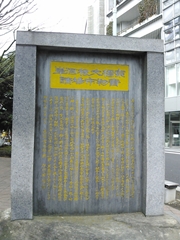 It seems that this year is the 350th anniversary of the establishment of the radish riverbank. (Because there is a theory that February is the month of birth, now is exactly that time!)
It seems that this year is the 350th anniversary of the establishment of the radish riverbank. (Because there is a theory that February is the month of birth, now is exactly that time!)
I feel the weight when I hear that it goes back to the age of the 4th shogun of Edo shogunate, Iezuna. To commemorate this, the members of the Kyobashi Daikon Riverside Association have been holding a commemorative event to distribute radish and various vegetables free of charge from two years ago in the middle of every month. February was scheduled for the 14th (Fri), but unfortunately it seems to have been canceled due to heavy snow. The next event will be held from noon on March 14 (Fri), so please visit us once.
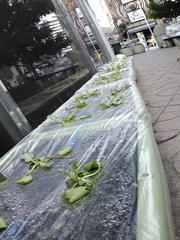 A monument is erected on the site of [Daikon Riverside], giving you a sense of history and personality. In addition, local people plant radish in planters after this history and grow it. I look forward to being able to reproduce a small [daikon riverbank] in modern times.
A monument is erected on the site of [Daikon Riverside], giving you a sense of history and personality. In addition, local people plant radish in planters after this history and grow it. I look forward to being able to reproduce a small [daikon riverbank] in modern times.
Then, as an aside, a restaurant called [Manchichi], which was located in this [daikon riverbank] appears in the historical novel's monument "Kihei Criminal Book". This store, which is closed in summer, is said to have been famous for its rabbit soup. It is a well-known spot for Onihei fans.
In the Edo period, carnivores were prohibited in principle, but it is known that they were eaten in various ways. "Rabbit" was also a kind of bird, and it was an OK sign. Therefore, rabbits are counted as "one bird, two birds ..." just like birds.
The Kyobashi neighborhood walks while thinking about such things. After that, whether to head to Ginza or Nihonbashi, for me, it is also Edo's "Shimonbashi".
![]() was held in 2007, it has been eight times as soon as possible.
was held in 2007, it has been eight times as soon as possible.![]() customers.
customers.![]() around love for her husband.
around love for her husband.![]()
![]()
![]() .
.![]()
 In the past, there was a vegetable unloading area on the northwest side of the Kyobashi River, and it was very busy called [daikon riverbank]. They traded vegetables brought from rural areas near Tokyo here, and it is the prototype of the fruit and vegetable market today. In the past, a lot of suburban vegetables such as Kameido Daikon and Nerima Daikon were transported using water transportation, and it seems that they were called "daikon riverbank" from that impression.
In the past, there was a vegetable unloading area on the northwest side of the Kyobashi River, and it was very busy called [daikon riverbank]. They traded vegetables brought from rural areas near Tokyo here, and it is the prototype of the fruit and vegetable market today. In the past, a lot of suburban vegetables such as Kameido Daikon and Nerima Daikon were transported using water transportation, and it seems that they were called "daikon riverbank" from that impression.
